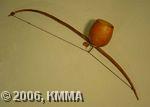


The umuduri is a musical bow consisting of a string (umurya) supported by a flexible wooden string bearer or bow (umuheto) 125-135 cm in length. The string is made from plant fibre, animal gut or (more recently) metal wire. A gourd is attached to the bow to act as a resonator. A wooden stick and the inzebe rattle are also used. Two loops bring the string closer to the bow and a third loop, the most important one, divides the string into two unequal lengths. This creates two different notes, usually a fourth or a fifth, as fundamental notes. This loop is attached to the gourd resonator by means of a cord. To keep the resonator and the musical bow apart, a cloth or a pad of banana peel is placed between the two to ensure that there is no direct contact between the bow and the gourd that might interfere with the sound produced.
To play the instrument, the bow is held in the left hand vertically in front of the body and the gourd is pressed against the body. A thin stick, used to strike the string, and an inzebe rattle are held in the right hand. In addition to the two fundamental notes that the string produces, the upper (longer) part of the string can be shortened using the index or middle finger, resulting in three notes: second/fourth or fifth.
The umuduri is mainly played by the Hutu and to a lesser extent by the Twa. The instrument is used on various occasions, such as during festivities, at official ceremonies, at the request of figures of authority, or by beggars to arouse pity. The umuduri is usually played solo and the performer sings at the same time, often accompanied by the audience clapping their hands. It is unusual for the umuduri to be played with other instruments.
The instrument is very popular both for its acoustic qualities and for its rhythmic cadence. The repertoire covers religion, politics, history, personal matters, everyday events, etc. The umuduri is found throughout the country, but is thought to originate from Tanzania rather than Rwanda. It was not introduced to Rwanda until the twentieth century. Its widespread distribution means that it is known by several names: umuduri, ibubura and umunahi.
For more information consult the following publications edited by the RMCA:
© KMMA/Jos GANSEMANS